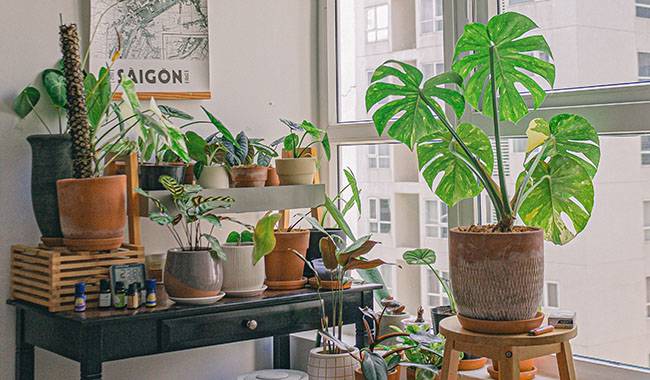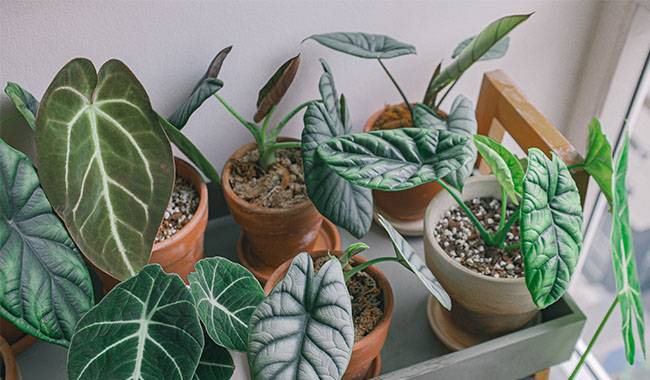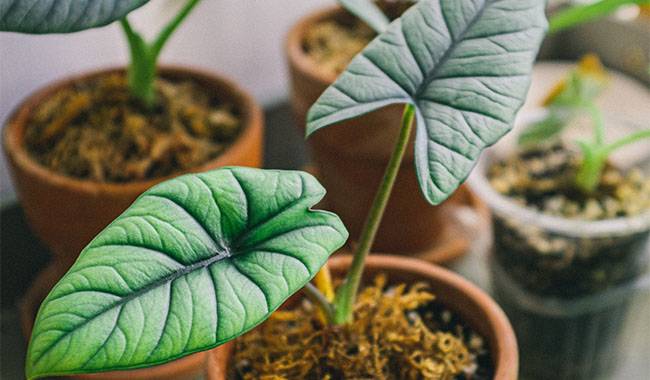
As winter approaches and gardening activity wanes, growers return to houseplants that were “neglected” during the summer months. The winter troubles begin lack of light, dry air, high temperatures… Most plants are not comfortable in these conditions. There are many ways to make your houseplants feel at home – even the less common ones. Here are a few that have worked well for me and my own houseplants. You will learn My Tips for Placing Indoor Plant in the ThumbGarden article.
HOUSEPLANTS LIVE IN WATER
Some of my plants are water-loving Nutsedges alternifolius. they generally like to have their roots in water, and they are very accustomed to water in their habitat. That’s right! I put the pots with balsam fir in a very deep container filled with pebbles brought from various festival spots, and then pour water so that the bottom of the pots with balsam fir are inside.
To keep the balsam fir from getting bored, I put a small pot with small-leaved ivy on top of the pebbles, above the water level – when it grows up, it drapes nicely over the edge of the container. And the celandine is fine – it’s moist, and so is the ivy – the humidity is high here. All in all, the plants in the room are a perfect combination.
By the way, this fountain pot is perfect for growing plants that have just taken root: I planted the pot with buds on the cobblestone with balsam fir. In this company, everything quickly took root and began to grow.
At work, I made a slightly different version with an adult balsam fir tree. In a large, deep dish, I placed a basin with cedar trees, large rocks, small pebbles, and small shells (my colleagues also brought things from the resort). In the water, I placed Limnobium laevigatum, a water plant similar to the floating weed, but bigger.
The aquarium snails moved in with it – and it just happened. I planted a small-leaved ivy in a pot with the balsam fir and found the combination very interesting.
The whole structure promotes relaxation: water, stones, greenery, floating limestone rafts, and snails crawling on pallets… At work, it makes perfect sense. Even irritated visitors will calm down without realizing it.
The only downside is that in such room conditions, the balsam fir trees grow like crazy and have to be finely divided every year. Well, and limestone grows well too, but it’s much easier to get it into good hands. With snails.
LIFE ON THE WATER
Streptocarpus sect likes moist air, but not wet feet all the time, and they are placed in a large tray on fine pebbles sprinkled evenly. The tray held 7 pots of colorful violets. These colors can be combined.
When my variety allows it (the violets somehow stay alive – some emerge, some go to friends and work), I do blue-white or violet-pink combinations. When they are not in bloom, I put the speckled ones in the middle to liven up the composition.
Watering from the tray is very easy. I just pour the water on the surface of the pebbles and let them decide how much to drink.
This makes caring for your violets much easier and saves space – a few large trays can hold dozens of pots. And they look quite interesting: a sort of mound of blooms.
CONDITIONS FOR HOME POTTED PLANTS IN PUBLIC AREAS

When the number of plants in the room (on the windowsill and other horizontal surfaces) exceeded a certain critical level (there was nowhere to put them), I began to organize them to live together without invading personal space.
I put large pots of oleander, strelitzia, and compact dracaena of maitake in a dry place near the window and added a pot of flowering hellebore for brightness (and replaced one as it bloomed and another as it started to bloom).
Around the large maidenhair, on a wide water dish, I placed and hung hung hung maidenhair ferns, double-pinnate Nephrolepis. it was moist enough to keep them from drying out the fragile foliage. However, the adrenaline clearing fallen leaves quickly becomes tiresome.
Another option for small potted plants: In a wide, low pot, I pour clay pebbles and place the potted plants on top to create various compositions. It is very convenient to concentrate growing plants there (there is not enough space for all of them next to Nutsedges). And there is not even necessarily a similar ecological requirement, because they can be easily moved from one place to another. Likewise, you can always add a flowering plant or two to brighten up the composition.
It works better if the plants have different growth patterns: I have tried this arrangement.
murraya paniculata, variegated small-leaved ivy, soleiroilia, saintpaulia , young chlorophytum;
coffee tree seedling, young chamedorea, ivy, balsam, gloxinia, geranium ;
young spathiphyllum, grown-up chamedorea, peperomia, outgrowth of cissus rhomboidus, small azalea ;
small jasmine-like gardenia, outgrowth of painted scindapsus, outgrowth of climbing anthurium, soleiroilia, variegated ivy.
If there are no small blooming things, I put a narrow container of water between the pots and place the cut flowers there.
A combination of small pots in a large tray also works well.
I’ve made some variations with rocks, gravel, pebbles – plenty of room for creativity!
INDOOR PLANTS IN THE APARTMENT

The desire to cram as many plants as possible into the available volume under indoor conditions prompted me to experiment with a lot of dividing plants. the combination of Ampelus variegated peperomia and an adult lemon plant was beautiful: the Radiator plants quickly covered the soil surface and hung over the edge of the pot, bringing lightness and elegance to the dull lemon. I repeated this combination in my work and it was a great success.
Soleirolia is good as a groundcover for all large plants, but proved to be a particularly good background for the large chamomile, masking the bright yellow streaks on its leaves.
Small-leaved variegated ivy has successfully coexisted with the green-leaved compact Dracaena fragrans. The “legs” of the oleander are covered with Peperomia.
No one is at a disadvantage; all are growing together. The roots of the groundcovers are at the top and the larger plants are at the bottom.
The amber plants are a good mix. Many plants are slow-growing and once planted in a common container, you won’t have to worry about replanting for several years. And how many cacti can you cram into a 12 inches (30 cm) pot!
Succulents and cacti require special handling – a good drainage system or a special container that can drain off excess water.
When the trend of growing cacti by the computer in the workplace passed, my colleagues and I organized them to live together in a shared container. We covered the surface with pebbles and placed them on the windowsill. The grateful plants of the cactus, which responded to the move with a cheerful look, bloomed the following year.
MULCHING HOUSEPLANTS, OR LIVING UNDERCOVER
Gardening also influences the way houseplants are cultivated: once you get used to mulch, you don’t even want to look at the bare soil of indoor flowers. But there are some plants that cannot be grown as groundcovers.
For example, Monstera- it’s dark underneath, like under a couch! Or spathiphyllum- the leaves are low and vigorous. The same goes for ferns. I don’t want to put anything under the strelitzia indoor plant – it will be suffocating.
In the fall, I received planting material for garden plants packed with strelitzia soil (so lucky!). This is the mulch material I use for plants that don’t like pests. Sphagnum moss doesn’t rot, holds moisture well, and looks organic in the pots.
The pebbles also work if you water from the tray because when you water from it, the pebbles are coated with whatever water is left in the tray. The coconut fiber works well, but I only have enough for the monster. On the other hand, the colorful leaves of the derivatives are nicely highlighted by the clay pebbles.
Dear reader: “Fiddling with houseplants is a wonderful relaxation, a rest for the soul, despite the complaints of loved ones about the clutter of their living spaces. In addition, besides being so useful, it’s also great for creativity. You can get the kids involved if you manage to pull them out of the gadgets. If not, you can get them to look for patterns online and try to do better. Maybe they’ll get involved.







